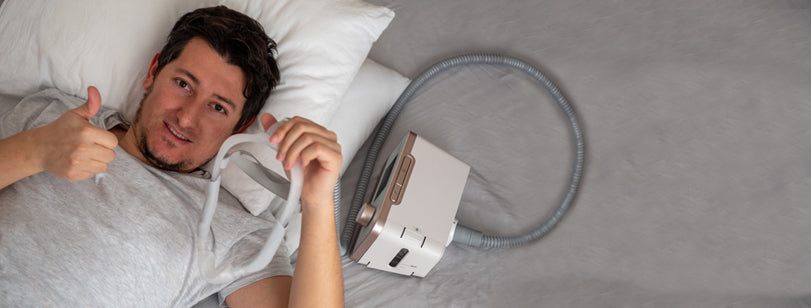
The Difference Between CPAP and Oxygen Therapy
Obstructive sleep apnea (OSA) is a disorder where the upper airways collapse as you sleep. This causes pauses in breathing until the body is prompted to awake for air.
This can happen frequently every hour through the night depending on the severity of your sleep apnea. One of the results is low blood oxygen levels, a condition known as hypoxemia.
There are two principal therapies a doctor may prescribe to address hypoxemia, CPAP therapy and oxygen therapy.
What Is CPAP and How Does it Help Treat Sleep Apnea
Continuous positive airway pressure (CPAP) therapy is one of the leading treatments for moderate to severe OSA. It involves a machine that supplies a steady stream of pressurized air through a tube connected to a mask you wear while sleeping.
Inhaling and exhaling the pressurized air prevents the collapse of the upper airways and the frequent breathing pauses.
The therapy also helps reduce or eliminate sleep apnea symptoms such as snoring, excessive daytime fatigue and morning headaches.
The mask required for the treatment may be worn over the nose and mouth or just the nose, and your doctor will help you select the most suitable mask. A correctly fitting mask is essential to prevent air leaking out and reducing the effectiveness of the treatment.
By keeping the airways open the treatment improves your breathing and prevents a drop in blood oxygen levels. You must use your machine every night, but it is compact and quiet, and will sit on a bedside stand or table.
What Is Oxygen Therapy and How Does It Work?
A doctor may also prescribe oxygen therapy to raise blood oxygen levels. The therapy uses a device called an oxygen concentrator. These tend to be bulkier than CPAPs, but work on a similar basis.
They also use the air within the room, but an oxygen concentrator is designed to remove nitrogen, leaving air which is between 87% to 93% pure oxygen.
This purified air is then delivered for inhalation through a tube, helping to boost blood oxygen levels. The air is compressed by the machine to help deliver a reliable pressure.
It may sound like using an oxygen tank, but the essential difference is that oxygen therapy can deliver a continuous supply of oxygen as it draws in air from the surrounding environment.
An oxygen concentrator has an electronic interface which helps to adjust air flow automatically and keep the machine operating in a reliable manner. Any adjustments to the delivery of oxygen levels should only ever be made in consultation with your doctor.
What Is the Difference Between CPAP and Oxygen Therapy?
The main difference between the two therapies is that oxygen therapy produces oxygen from the surrounding air. CPAPs do not do this, but instead deliver a stream of positive air to help ensure the upper airways are free from any blockages.
By preventing the collapse of the airways you might not need supplemental oxygen as your blood oxygen levels may be elevated to better levels just from the air you inhale.
An oxygen concentrator alone will not prevent the airways from collapsing and causing fragmented sleep. Therefore, if the airways are blocked, using an oxygen concentrator will not deliver the oxygen to the lungs required to boost blood oxygen levels.
If positive airway pressure alone is not working to prevent hypoxemia, your doctor may recommend an oxygen concentrator as well to improve blood oxygen levels.
CPAP vs Oxygen Therapy – Who Wins?
As obstructive sleep apnea is the most common form of the sleep disorder, most people will experience frequent night time awakenings as the body reacts to breathing pauses caused by collapsed upper airways.
This impacts on the quality of sleep and can result in sleep deprivation, placing you at increased risk of serious health complications such as heart disease, stroke and diabetes.
CPAP is a leading treatment for this sleep disorder because it uses positive air pressure to keep the airways open and reduce or eliminate the symptoms of this disorder.
Oxygen therapy does not achieve this and alone can’t end the frequent interruptions to sleep caused by OSA. It also doesn’t tackle the other symptoms of sleep apnea such as daytime fatigue and heavy snoring.
A doctor may prescribe an oxygen concentrator if you are not compliant with CPAP.
Increasing blood oxygen levels using an oxygen concentrator has been seen to benefit people with a chronic obstructive pulmonary disease (COPD) who struggle to breathe in enough oxygen. However, using oxygen alone to tackle COPD for someone with OSA could actually make their breathing worse when they sleep.
Continuous positive airway pressure therapy is key to keeping the airways clear and enabling someone with OSA to sleep without interruptions from breathing difficulties.
An oxygen concentrator may be recommended as well if oxygen levels remain low and the lungs are not able to extract enough oxygen through the open airways.
Sources:
https://www.verywellhealth.com/oxygen-therapy-in-sleep-apnea-3015220
https://sleepapnea.sleep-disorders.net/clinical/cpap-oxygen-therapy
https://www.cpap.com/blog/cpap-machines-different-oxygen-concentrators/
